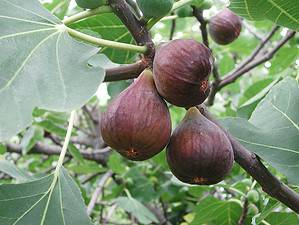Technically sister species to one another, are there any true differences between a cypress vs juniper tree? These trees come in a variety of sizes and shapes, ranging in height and ornamental use. But are there any true similarities and differences between these fantastic landscaping trees, or are they more closely related than we think?
In this article, we will compare and contrast a cypress tree with a juniper tree so that you can fully understand the differences between them. And we will address what these trees look like as well as how they prefer to grow. Finally, we will tell you what these trees are typically used for as well as how you can best take care of one in your own backyard. Let’s get started now!
Comparing Cypress vs Juniper
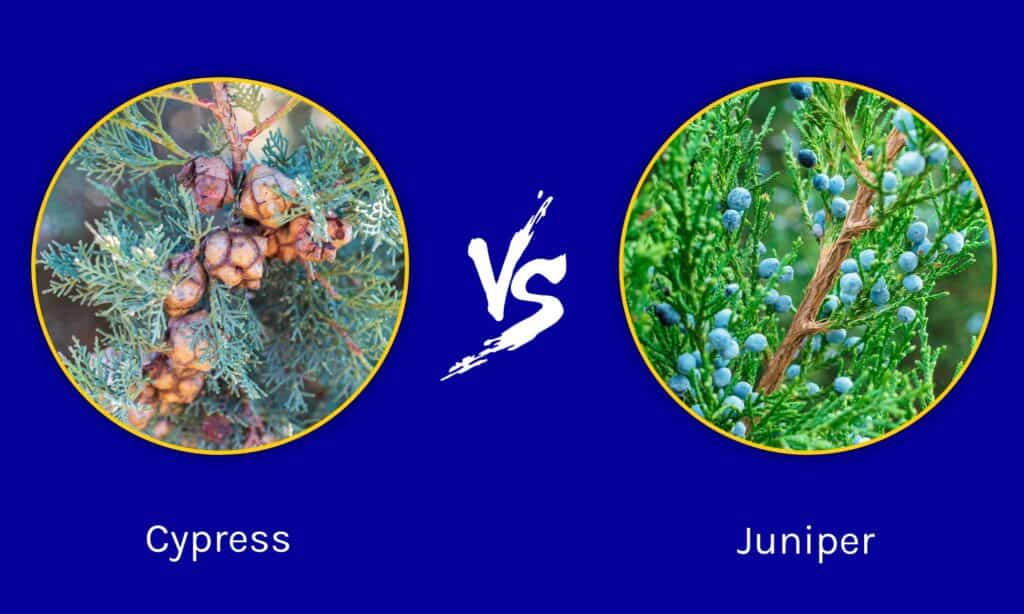
| Cypress | Juniper | |
|---|---|---|
| Plant Classification | Cupressus | Juniperus |
| Description | Trees and shrubs ranging in height depending on variety (5-130 ft). Produces needles when young and larger leaves when older, alongside oblong cones and seed pods. Bark is smooth and flaky | Trees and shrubs ranging in height depending on variety (10-100 ft). Produces flat needles in a branching pattern alongside bluish gray berries or cones. Bark gets flakier with age and comes in shades of gray and brown |
| Uses | Cultivated for gardens and landscaping around the world, as well as some timber uses; primarily an ornamental tree | Has a variety of uses, given its dense but flexible wood; popular for ornamentation. Ideal for making tools and fences, and the berries are also key in gin production |
| Origin and Growing Preferences | Native to the Mediterranean, Asia, and North America; thrives in full sun and needs plenty of water when young | Native to Tibet, Africa, and Asia; open to a variety of climates and soil types, though make sure you find the right cultivar for your region |
| Hardiness Zones | 6 through 10 | 7 through 10 |
Key Differences Between Cypress vs Juniper
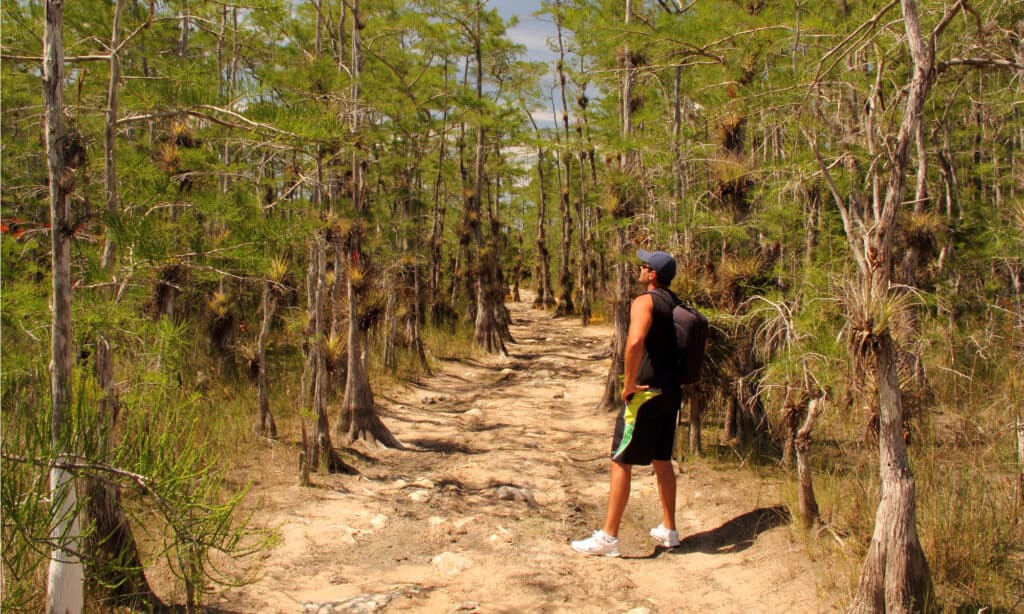
Many cypress tree varieties grow taller than juniper trees, but their heights also overlap often.
©William Silver/Shutterstock.com
There are a number of key differences between cypress trees and juniper trees. For example, cypress and juniper belong to the same plant family, but they are their own distinct genuses from each other. Technically, all juniper trees are cypress trees, but not all cypress trees are juniper trees. In addition to this, cypress trees grow shorter roots on average compared to juniper trees. Juniper berries are used in gin production, While most cypress trees are cultivated for landscaping alone.
Let’s go over all of these differences and a few others in detail now.
Cypress vs Juniper: Classification
While both cypress and juniper trees belong to the cypress plant family, making them sibling trees, they technically belong to their own distinct genuses. For example, cypress trees belong to the Cupressus genus, while juniper trees belong to the Juniperus genus. However, given their close relation, these trees have some undeniable similarities to each other.
Cypress vs Juniper: Description

Depending on age, cypress trees have leaves of a more needle-like appearance compared to the lacy and intricate leaves found on juniper trees.
©iStock.com/SbytovaMN
Identifying a cypress or a juniper tree in a forest can be extremely difficult. These trees are closely related and appear extremely similarly to one another, but there are a few things you can use to tell them apart. For example, many cypress tree varieties grow taller than juniper trees, but their heights also overlap often.
Besides the general shape, size, and color of these trees, their leaves are slightly different. Depending on age, cypress trees have leaves of a more needle-like appearance compared to the lacy and intricate leaves found on juniper trees. Besides this, most cypress trees have cones and unique seed pods, while juniper trees have bluish gray berries that are occasionally edible.
Cypress vs Juniper: Uses
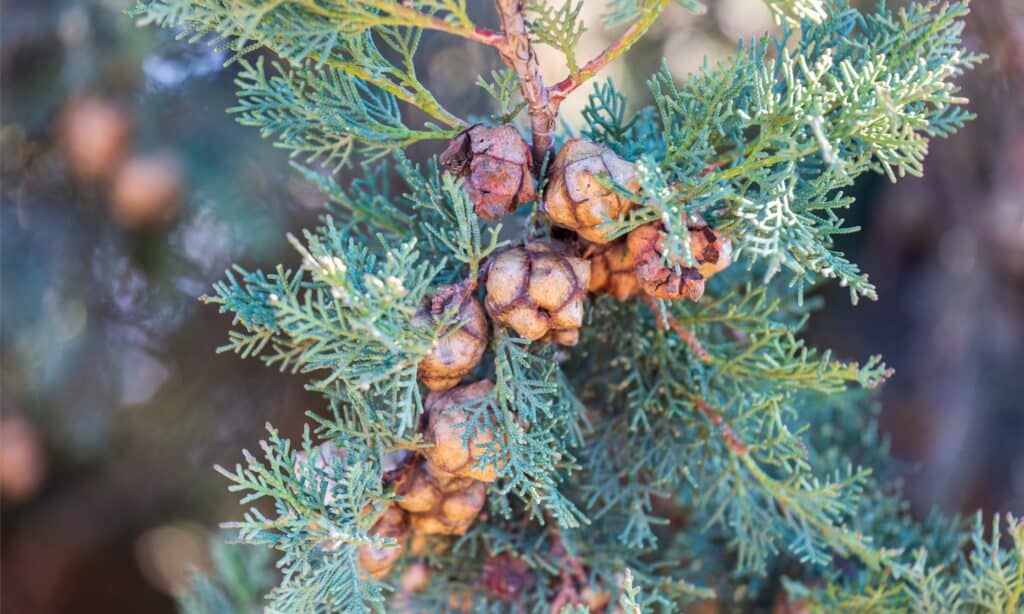
While cypress trees are popular in landscaping, many cypress trees have shallow roots compared to the average juniper tree.
©iStock.com/Vladimir1965
Cypress trees and juniper trees are used in similar ways, given they are closely related. However, juniper trees are utilized for more things compared to cypress trees overall. The average cypress tree is used in landscaping or ornamental gardens, while juniper trees are used to build more things by comparison. However, there are certain varieties of cypress trees that are utilized in timber production, much like juniper trees.
While juniper trees are also popular in an ornamental or landscaping setting, juniper trees also produce berries that are edible and key in gin production, something that the cypress tree does not do. While cypress trees are popular in landscaping, many cypress trees have shallow roots compared to the average juniper tree. This means that cypress trees often struggle to regrow if they are toppled by wind, but juniper trees often regrow with ease.
Cypress vs Juniper: Origin and How to Grow
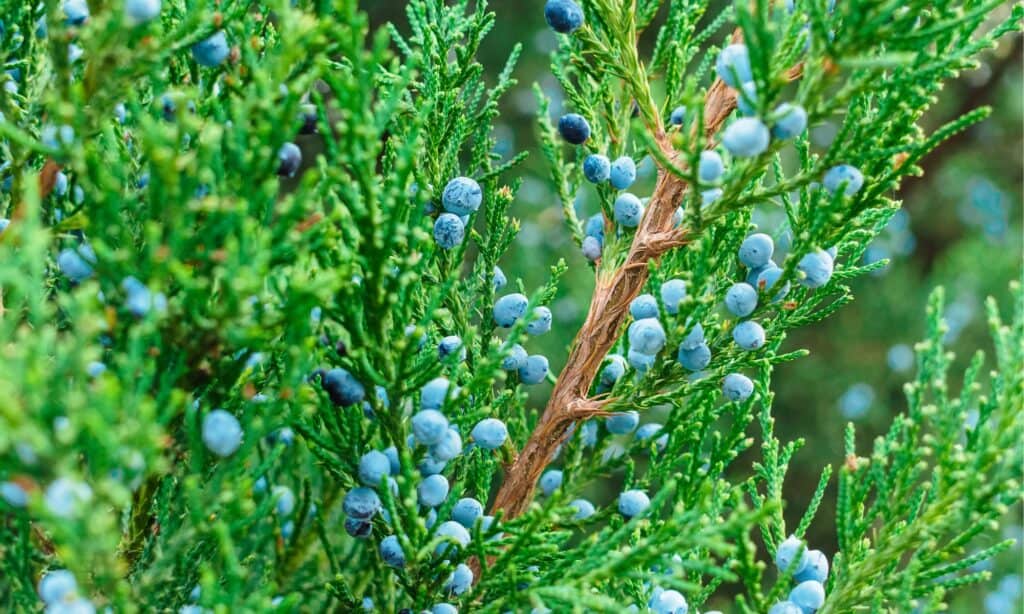
Juniper trees grow best in hardiness zones 7 through 10, while some cypress tree varieties allow you to grow them in zones 6 through 10.
©iStock.com/Yuliya Shauerman
Cypress trees and juniper trees have different locations of origin, though both of these trees grow around the world and are difficult to pinpoint. However, many experts agree that cypress trees originated in the Mediterranean, Asia, and North America, while juniper trees originated in Tibet, Africa, and Asia.
These origins depend on the specific cultivar or tree variety you are hoping to plant, which will also greatly affect how to grow your cypress or juniper tree. For the most part, most cypress trees need more sunlight than the average juniper tree. In addition, juniper trees have more specific soil needs compared to the average cypress tree, but it all depends on the specific variety for your region!
Cypress vs Juniper: Hardiness Zones
The final potential difference between cypress trees and juniper trees is how hardy they are and where they grow best in the United States in particular. For example, cypress trees are more cold hardy compared to juniper trees on average. Juniper trees grow best in hardiness zones 7 through 10, while some cypress tree varieties allow you to grow them in zones 6 through 10. However, always make sure you have the right variety for your region before planting either of these two fantastic ornamental trees!
The photo featured at the top of this post is © iStock.com/SbytovaMN
Sources
- Water Use and Soil Moisture Relationships on Western Juniper Trees at Different Growth Stages, Available here: https://www.mdpi.com/2073-4441/12/6/1596
- Optimization of the Process Parameters Exceeding Extraction and Characterization of Gin Flavor from Juniper Berries, Available here: https://chemical.journalspub.info/index.php?journal=JCCST&page=article&op=view&path%5B%5D=778
Thank you for reading! Have some feedback for us? Contact the AZ Animals editorial team.




